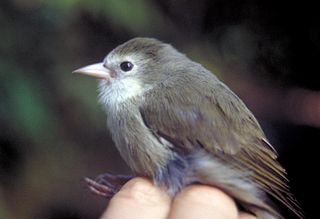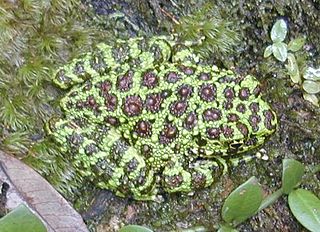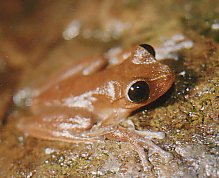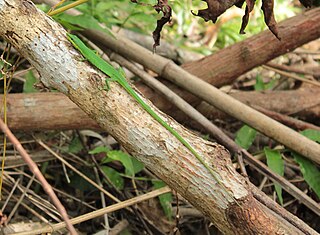 W
WThe ʻakikiki, also called the Kauaʻi creeper, is a critically endangered Hawaiian honeycreeper endemic to Kauaʻi, Hawaiʻi.
 W
WThe Amargosa toad, previously known as Bufo nelsoni, is a species of toad in the family Bufonidae. It was at one time considered to be a subspecies of the western toad. It is threatened by habitat loss and is classified by the IUCN as being "endangered".
 W
WThe Aniliidae are a monotypic family created for the monotypic genus Anilius that contains the single species A. scytale. Common names include American pipe snake and false coral snake. It is found in South America. This snake possesses a vestigial pelvic girdle that is visible as a pair of cloacal spurs. It is ovoviviparous. It is non-venomous, and its diet consists mainly of amphibians and other reptiles. Currently, two subspecies are recognized, including the typical form described here.
 W
WAnolis poncensis is a species of lizard of the family of Dactyloidae. The species is endemic to Puerto Rico. It was first identified in Ponce, in the hills three miles east of the city. The Puerto Rico Department of Natural and Environmental Resources considers it a "vulnerable species".
 W
WThe tailed frogs are two species of frogs in the genus Ascaphus, the only taxon in the family Ascaphidae. The "tail" in the name is actually an extension of the male cloaca. The tail is one of two distinctive anatomical features adapting the species to life in fast-flowing streams. These are the only North American frog species that reproduce by internal fertilization.
 W
WBoiga kraepelini, commonly known as the square-headed cat snake, Kelung cat snake, or Taiwanese tree snake is a species of mildly venomous snake in the family Colubridae. The species is endemic to East Asia and Southeast Asia. Its specific name, kraepelini, honours Karl Kraepelin, a German naturalist. The common name, Kelung cat snake, refers to its type locality, Keelung in northern Taiwan.
 W
WThe Glorioso snake-eyed skink is a species of lizard in the family Scincidae. It is endemic to the Glorioso Islands.
 W
WCtenosaura palearis, commonly known as the Guatemalan spiny-tailed iguana, is a species of spiny-tailed iguana endemic to the Motagua Valley, Guatemala.
 W
WCyclura rileyi, commonly known as the Bahamian rock iguana or the San Salvador rock iguana, is a critically endangered species of lizard in the family Iguanidae. The species is native to three island groups in the Bahamas, and is in decline due to habitat encroachment by human development and predation by feral dogs and cats. There are three subspecies: the Acklins ground iguana, the White Cay iguana, and the nominotypical subspecies.
 W
WDendropsophus phlebodes, the San Carlos treefrog or San Carlos dwarf treefrog, is a species of frog in the family Hylidae. It is found in western Colombia, Costa Rica, Nicaragua and Panama. Its natural habitats are tropical moist lowland forests, but it may also occur in disturbed habitats. It is threatened by habitat loss.
 W
WDraco mindanensis, commonly known as the Mindanao flying dragon, is a lizard species endemic to the Philippines. Characterized by a dull grayish brown body color and a vivid tangerine orange dewlap, this species is one of the largest of the genus Draco. It is diurnal, arboreal, and capable of gliding.
 W
WThe Florida sand skink is a species of lizard in the family Scincidae, the skinks. It is endemic to Florida in the United States.
 W
WGambelia sila, commonly known as the blunt-nosed leopard lizard, is a species of lizard in the family Crotaphytidae. The species is endemic to southern California.
 W
WGekko kuhli, commonly known as Kuhl's flying gecko or the common flying gecko, is a species of lizard in the family Gekkonidae. The species is endemic to Asia.
 W
WThe grotto salamander, also called the Ozark blind salamander, is a species of salamander in the family Plethodontidae. It is now considered a member of the genus Eurycea, but was originally described as Typhlotriton speleus. It is endemic to the United States, specifically the karst regions beneath the Springfield and Salem Plateaus of the Ozark Mountains part of Arkansas, Kansas, Missouri, and Oklahoma. Its natural habitats are freshwater springs, inland karsts, and caves. It is not currently threatened, but vulnerable to changes in groundwater quality and reduction in bat population.
 W
WHeosemys is a genus of freshwater turtles in the family Geoemydidae. The genus Heosemys was split out of the related genus Geoemyda by McDowell in 1964.
 W
WIshikawa's frog is a species of frog in the family Ranidae. It is endemic to Okinawa Island, one of the Ryukyu Islands of Japan. It has been described as the most beautiful frog in Japan.
 W
WLepidodactylus planicaudus, also known as the Mindanao scaly-toed gecko or small broad-tailed smooth-scaled gecko, is a species of gecko. It is endemic to the Philippines.
 W
WThe Leptotyphlopidae are a family of snakes found in North America, South America, Africa and Asia. All are fossorial and adapted to burrowing, feeding on ants and termites. Two subfamilies are recognized.
 W
WLimnonectes namiyei is a species of frog in the family Dicroglossidae. It is endemic to Okinawa Island, Japan. It is named after Motoyoshi Namiye, a Japanese naturalist and herpetologist. Its common name is Okinawa wart frog or Namiye's frog; the latter name is also spelled Namie's frog.
 W
WLuperosaurus macgregori, known commonly as MacGregor's wolf gecko or McGregor's flapped-legged gecko, is a species of gecko, a lizard in the family Gekkonidae. The species is endemic to the Philippines.
 W
WThe Florida sand skink is a species of lizard in the family Scincidae, the skinks. It is endemic to Florida in the United States.
 W
WNyctimystes is a genus of tree frogs in the family Pelodryadidae. They are principally Papuan species, but also inhabit islands in the Moluccas. All species in this genus have one distinct feature that separates them from other species in the family, the lower eyelid is marked with pattern of lines, veins, or dots. This feature presumably acts as camouflage when the frogs are at rest during the day.
 W
WThe ʻakikiki, also called the Kauaʻi creeper, is a critically endangered Hawaiian honeycreeper endemic to Kauaʻi, Hawaiʻi.
 W
WPholidoscelis wetmorei is a species of lizard in the family Teiidae (whiptails). It is endemic to Puerto Rico. Its common names include the Puerto Rican blue-tailed ameiva, Wetmore's ameiva, and blue-tailed ground lizard.
 W
WThe pig frog is a species of aquatic frog found in the Southeastern United States, from South Carolina to Texas. Some sources also refer to it as the lagoon frog or the southern bullfrog.
 W
WThe Great Basin gopher snake, also known as the bull snake, is a subspecies of nonvenomous colubrid endemic to the western part of the United States and adjacent southwestern Canada.
 W
WRana longicrus, also known as the Taipa frog or long-legged brown frog, is a species of frog in the family Ranidae. It is endemic to northern and central Taiwan.
 W
WThe Aztec thrush is a species of bird in the family Turdidae. It is found mainly in Mexico, but vagrants are occasionally seen in the United States. Its natural habitat is montane forests. The IUCN Red List denotes it as a least-concern species.
 W
WSceloporus merriami, commonly known as the canyon lizard, is a species of lizard in the family Phrynosomatidae. The species is native to the south-western United States and northern Mexico.
 W
WSibon longifrenis is a species of snake in the family Colubridae. It is found in Panama, Costa Rica, Honduras and Nicaragua.
 W
WStejneger's beaked whale, also known as the Bering Sea beaked whale or the saber-toothed whale, is a relatively unknown member of the genus Mesoplodon inhabiting the northern North Pacific Ocean. Leonhard Hess Stejneger collected the type specimen on Bering Island in 1883, from which Frederick W. True provided the species' description in 1885. In 1904, the first complete skull was collected, which confirmed the species' validity. The most noteworthy characteristic of the males is the very large, saber-like teeth, hence the name.
 W
WTakydromus dorsalis, the Sakishima grass lizard, is a species of lizard in the family Lacertidae. It is endemic to Ishigaki Island in Japan.
 W
WThe Texas banded gecko is a species of small gecko native to the southwestern United States and northern Mexico.
 W
WTropidophorus misaminius, the Misamis waterside skink, is a species of skink. It is endemic to the Philippines, where it is found on several islands at elevations of 350 to 1500 m above sea level. Its body is covered with pointed scales that likely deter predators. This species typically lives at the banks of streams and rivers and in forests, where they live under decayed logs. Near water they usually hide under rocks and warm up under the sun on those rocks when there is no danger around.